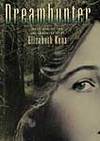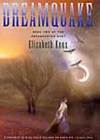 Elizabeth Knox is one of those writers who should be running the radar, if there were any justice in the world. Pointing here and there, singling out interesting writers that we’d then all read. At least, I’d trust her to based on her books.
Elizabeth Knox is one of those writers who should be running the radar, if there were any justice in the world. Pointing here and there, singling out interesting writers that we’d then all read. At least, I’d trust her to based on her books.
I first discovered Knox’s work the way I’ve found a not-insubstantial number of my favorite authors–Kelly Link gave me a copy of one of her books. I believe it was Black Oxen![]() , but it could have been Billie’s Kiss
, but it could have been Billie’s Kiss![]() . Or maybe The Vintner’s Luck
. Or maybe The Vintner’s Luck![]() . Either way, I read all three in short order, and began keeping an eye out for others. When Daylight
. Either way, I read all three in short order, and began keeping an eye out for others. When Daylight![]() came out, I read it on an airplane on the way to San Francisco, unconsciously gripping it so tightly that my hands were sore that night. I was hooked. And who wouldn’t be? These are deeply unconventional novels–love between a man and an angel, vampires haunting Italian caves, a time traveling search for a non-human father–not one like the other, but always with that same assured, lush voice behind them.
came out, I read it on an airplane on the way to San Francisco, unconsciously gripping it so tightly that my hands were sore that night. I was hooked. And who wouldn’t be? These are deeply unconventional novels–love between a man and an angel, vampires haunting Italian caves, a time traveling search for a non-human father–not one like the other, but always with that same assured, lush voice behind them.
So when I heard that Knox had written a YA "duet" (as opposed to the usual trilogy), I was excited, but also worried. Would this writer have pinched in her oddness to write for younger readers? It happens so often: an interesting novelist for adults writes a simplistic, heavy-handed book for children or teenagers, not understanding that if anything the borders are open even wider in this field than in the one they’ve been publishing in. I shouldn’t have worried.
The two books–Dreamhunter (or The Rainbow Opera in the UK) and Dreamquake–that comprise the Dreamhunter Duet are Knox’s masterpiece to date. This is a majestic and sweeping work: a fantasy classic that should be around for a long time to come. Both novels received excellent reviews when they came out, in 2006 and this year respectively, and the first landed on several lists here in the U.S.(scroll and click) so far. Yet I don’t hear people talking about them. I certainly don’t encounter a lot of people who are pretty well-read in terms of recent fantasy who’ve read them. And that’s why I’m posting about them today, in the hope of changing that.
Dreamhunter Duet are Knox’s masterpiece to date. This is a majestic and sweeping work: a fantasy classic that should be around for a long time to come. Both novels received excellent reviews when they came out, in 2006 and this year respectively, and the first landed on several lists here in the U.S.(scroll and click) so far. Yet I don’t hear people talking about them. I certainly don’t encounter a lot of people who are pretty well-read in terms of recent fantasy who’ve read them. And that’s why I’m posting about them today, in the hope of changing that.
Set in Southland, an Edwardian-era version of New Zealand, the books chronicle events surrounding the intersection between the current society and a geographic anomaly known as "the Place" that only "dreamhunters" can visit. Teenage Laura Hame’s father Tziga discovered the Place twenty years earlier, pioneering the art of retrieving dreams and performing them for huge sleeping audiences. This has now become big business. Like anything that becomes the focus of an economy, however, we quickly figure out that dreams are also being put to some mysterious, darker purpose. Laura’s father may be a casualty of that sinister effort. When Tziga disappears, she must try to find him, notably with the help of a sand golem called Nown she creates in the dreamland. Laura and a host of other characters spend the course of both novels uncovering secret after secret, until finally the secret of the Place itself is revealed. Along the way, we experience the story through the eyes of not only Tziga and Laura, but her cousin Rose and her family, Laura’s romantic interest dreamhunter Sandy Mason, various rangers, Nown, and corrupt bureaucrat Cass Doran, to name just a few.
 Knox could have chosen to tell the story as a pure family saga. But while the two families central to the story are important, they alone don’t make up the story. She could also have chosen to tell it through a tight lens of Laura’s point of view, making it a more personal tale of a girl coming to grips with the loss of her parents and with her own destiny. Or what if she told it from Tziga’s point of view, chronicling the first and most troubled dreamhunter’s journey? Any of these more conventional decisions would have resulted in a far less rich world and less satisfying story. Because of this choice, the balance of Southland becomes the balance of the world. We are keenly aware of how many places there are where that balance could be lost forever. These novels are a master class in the successful use of omniscient point of view to widen the borders of a story.
Knox could have chosen to tell the story as a pure family saga. But while the two families central to the story are important, they alone don’t make up the story. She could also have chosen to tell it through a tight lens of Laura’s point of view, making it a more personal tale of a girl coming to grips with the loss of her parents and with her own destiny. Or what if she told it from Tziga’s point of view, chronicling the first and most troubled dreamhunter’s journey? Any of these more conventional decisions would have resulted in a far less rich world and less satisfying story. Because of this choice, the balance of Southland becomes the balance of the world. We are keenly aware of how many places there are where that balance could be lost forever. These novels are a master class in the successful use of omniscient point of view to widen the borders of a story.
That rich oddness Knox does so well is present–where else are you going to find sexual tension with a sand golem?–but the novel is very grounded as well. The fantasy world of the Place is as real–as dirty and full of politics and secrets–as the "real" world. I don’t want to spoil the ending so I won’t go into detail, but Knox bravely draws her story to a grand finish in a way so surprising I can’t immediately think of another fantasy where something similar happens. I hope you’ll do me the favor of reading these books. They are fabulous.
And today’s other Radar stops are:
A Chair, A Fireplace & A Tea Cozy: The President’s Daughter series by Ellen Emerson White
Big A, little a: The Tide Knot by Helen Dunmore
Jen Robinson’s Book Page: The Zilpha Keatley Snyder Green Sky trilogy
Bildungsroman: Innocence by Jane Mendelsohn: A Discussion Part 1
Chasing Ray: Innocence by Jane Mendelsohn: A Discussion Part 2
lectitans: Innocence by Jane Mendelsohn: A Discussion Part 3
Finding Wonderland: The House on Hound Hill by Maggie Prince
Miss Erin: The Reb & Redcoats and Enemy Brothers, both by Constance Savery
Bookshelves of Doom: Harry Sue by Sue Stauffacher
Interactive Reader: Shake Down the Stars by Frances Donnelly
Chicken Spaghetti: Pooja Makhijani guest blogs with Romina’s Rangoli
Writing & Ruminating: Dear Mr. Rosenwald by Carole Weatherford
Ooh, these sound really, really good, Gwenda. Count me as sold.
I’m reading about so many fascinating books this week that I’ve never even heard of! My TBR list is growing exponentially.
Y’know, I picked up these two because of you — they were on the side column of your blog, and I thought I’d just check ’em out because the covers were pretty. Big props to you for that — in two days I chewed through first one and then the other. They’re flat out amazing.
I think it was Justine who first made me notice these two, and I’m most grateful, since they’re just as excellent as you say Gwenda!
I’ve loved her other novels, especially ‘The Vintner’s Luck’, but I just bogged down on the first of these. Her dreaming concept reminded me too much of John Brunner’s ‘The Whole Man’ I suppose. Then the stack of ‘to be read’ books that grows and tumbles constantly beside my bed became to demanding. So I’ll just look forward to her next book in a different mode…
Charles
Hey, Charles! I will admit that the first 100 pages or so of the first book isn’t necessarily a grabber, so if you ever feel moved to give them another try… I also think the second one is stronger overall, and does a good job of condensing what you need to know from the first book. But, yes, LOVE Vintner’s Luck. Love it.
My God I loved these two!! They were very complex, but the end just pulled the whole thing together in the most amazing way. I am truly stunned!
i havent read them yet but im about to start tonight stephanie meyer has them on her recommended read list so im giving them a go…i just finished her book the host …wow its powerful nothing like her twilight saga but just as well thought out ….